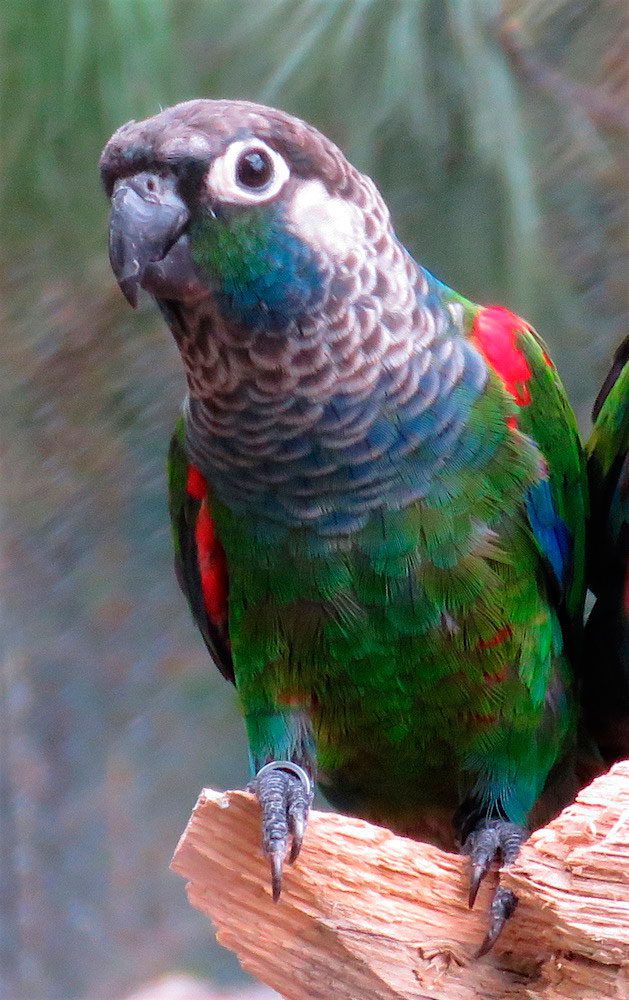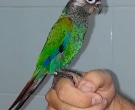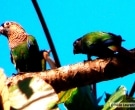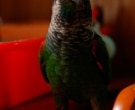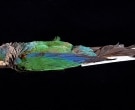Content |
|---|
Description:
24 cm.. in length and 70–80 grams in weight.
The Pearly Parakeet (Pyrrhura lepida) has the head dark blackish brown with mottled light on nape; ear-coverts creamy white; cheeks pale bluish green.
Upper mantle blue; robe bottom until uppertail-coverts, green. Scapulars green at the base, blue down; lesser wing coverts slightly green tinted olive; median coverts and older, mainly blue; some red at the leading edge of wing . Flight feathers Blue above, secondaries with green in the outerweb; dark gray below. Underwing-coverts bright red. Sides of the neck, the throat and the top chest, mainly brown with some blue marks and points yellowish brown, which gives an overall scaled aspect; The underparts remaining are green with blue on the flanks and the thighs. Upper, the tail mainly brown, green in the basal area and narrow blue tips. Bill black-brown; bare periophthalmic grey; irises dark brown; legs black slate.
The plumages of both sexes are, apparently, similar.
taxonomic history
Confusing taxonomic history: until recently known as Pyrrhura perlata, but that name is actually applied to the known way long as Pyrrhura rhodogaster, currently a synonym for the species Pyrrhura perlata; the current species therefore assumes his next oldest name, Pyrrhura lepida. Forms a pair of species with parapatric Pyrrhura perlata, with which it is sometimes considered conspecific; the recent molecular phylogeny indicated that the closest relatives of these two are the Pyrrhura frontalis and Pyrrhura molinae.
- Sound of the Pearly Parakeet.
Description 3 subspecies:
-
Pyrrhura lepida anerythra
(Neumann, 1927) – Similar to the species nominal but with the chest, the belly and cheeks green with occasional shades of blue.
-
Pyrrhura lepida coerulescens
(Neumann, 1927) – Similar to the species nominal, but with the forecrown and crown brown, gray throat and upper chest, green on the upper cheeks; bluer in the lower chest
-
Pyrrhura lepida lepida
(Wagler, 1832) – Nominal.
.
Habitat:
The Pearly Parakeet, usually, inhabits moist terra firme forests. The species has been observed in forest edges, clear areas and second growth.
They are seen in flocks of up to ten birds, particularly in places where food is plentiful.
Reproduction:
They nest hollow logs. The laying is of 3-4 eggs incubados during 23 days; the hatchling needs close to 7 weeks for independence.
Food:
probably catkins, small fruits and flowers.
Distribution and status:
Size of its range (breeding/resident): 585.000 km2
The Cotorra Pulcra is endemic to Northeast Brazil, to the South of the Amazonia. Observed around the basin Xingú and its tributaries, from the Pracui River and the left bank of Tocantins River, and from Belem and the Capim River, in For, east to around Sao Luis in maranhão, and from northern maranhão to the East of Rosary, although apparently no longer in some coastal areas, where according to sources, They were formerly quite common.
Today are rare and extinct in many parts of their former range (for example, North of maranhão) due to large-scale deforestation, although they are, apparently, tolerant habitat alterations.
The coerulescens subspecies It is near extinction due to the almost total loss of their habitat. The species is found in protected areas but its integrity is compromised by the illegal logging.
Distribution 3 subspecies:
-
Pyrrhura lepida anerythra
(Neumann, 1927) – Alto Xingu tributaries, from the Pracui River and the left bank of Tocantins River
-
Pyrrhura lepida coerulescens
-
Pyrrhura lepida lepida
(Wagler, 1832) –Nominal. Bethlehem and Capim River in For, to the this to Sao Luis in maranhão
Note:
Pyrrhura lepida is the new name of the taxon Pyrrhura perlata, whose name has been shown to be applied first to an immature bird of that species, Crimson-bellied Parakeet (Pyrrhura perlata).
Conservation:
State of conservation ⓘ |
||
|---|---|---|
 Vulnerable ⓘ (UICN)ⓘ
Vulnerable ⓘ (UICN)ⓘ
| ||
• Current category of the Red List of the UICN: Vulnerable.
• Population trend: Decreasing.
• Population size : 6700 individuals.
Rationale for the Red List category
From a model of future deforestation in the Amazon basin, While shows some tolerance degraded landscapes, It suspected that the population of this species decline rapidly over the next three generations and, therefore, It has risen to Vulnerable.
Justification of the population
The population is preliminarily estimated at the number of at least 10.000 individuals, approximately equivalent to 6.700 mature individuals. This requires confirmation.
Justification of trend
It is suspected that this species has lost between 47 and the 64,5% of habitat suitable within their distribution during three generations (18 years) starting from a model of deforestation Amazon (Soares-Filho et to the ., 2006, Bird et to the ., 2011). But, because the species seems to have some degree of tolerance to habitat degradation (A. Lees in litt ., 2011), It suspected to decline by 30-49% during three generations.
Threats
Despite an apparent tolerance of some degradation of the habitat, It is perhaps close to extinction in coastal areas of northern maranhão, due to the large scale deforestation (Juniper and Parr, 1998). They are distributed within protected areas, but its integrity is compromised by the illegal logging (Juniper and Parr 1998). Deforestation in the Amazon basin is expected to increase as land is cleared for cattle ranching and soy production, provided by the expansion of the road network (Soares-Filho et to the. , 2006). The proposed changes to Brazilian Forest Code reduce the percentage of land that a private owner is legally required to keep as forest and include an amnesty for owners who deforested before July 2008 (That they would later be absolved of the need to reforest the illegally cleared land) (Bird et to the., 2011).
"Pearly Parakeet" in captivity:
Rare in captivity.
It is a bird Vulnerable nationally in Brazil and protected by CITES Appendix II; each captive specimen of this species that is capable of reproducing, must be placed in a well-managed captive breeding program and not sold as a pet, in order to ensure its long-term survival.
Alternative names:
– Pearly Conure, Pearly Parakeet (English).
– Conure perlée, Perriche perlée, Perruche perlée (French).
– Blausteißsittich (German).
– tiriba, tiriba-de-barriga-vermelha, Tiriba-peróla, tiriba-pérola (Portuguese).
– Catita cola granate, Cotorra Pulcra, Cotorra Ventrirroja (español).
scientific classification:

– Order: Psittaciformes
– Family: Psittacidae
– Genus: Pyrrhura
– Scientific name: Pyrrhura lepida
– Citation: (Wagler, 1832)
– Protonimo: Sittace lepida
Images Pearly Parakeet:
Videos "Pearly Parakeet"
Pearly Parakeet (Pyrrhura lepida)
Sources:
– Avibase
– Parrots of the World – Forshaw Joseph M
– Parrots A Guide to the Parrots of the World – Tony Juniper & Mike Parr
– Birdlife
– Photos:
(1) – Pyrrhura lepida by Florin Feneru – Flickr
(2) – Pyrrhura lepida coerulescens Neumann, 1929 – Huub Veldhuijzen van Zanten / Naturalis Biodiversity Center [CC BY-SA 3.0], via Wikimedia Commons
(3) – Pearly Parakeet (Pyrrhura lepida) also known as the Pearly Conure in aviculture. A pet parrot By manginwu (originally posted to Flickr as my name is twoday.) [CC BY-SA 2.0], via Wikimedia Commons
(4) – Tiriba-perola [Pearly Parakeet] by Helio Lourencini – Flickr
(5) – Tiriba pearl (Pyrrhura perlata) – www.avesilvestre.com.br
(6) – Parrots A Guide to the Parrots of the World – Tony Juniper & Mike Parr
– Sounds: GABRIEL MILK, XC212988. accessible www.xeno-canto.org/212988
